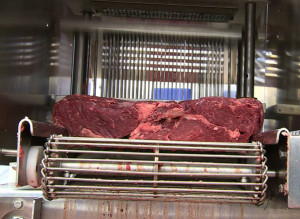The risk of Shiga toxin-producing Escherichia coli (STEC) survival in blade-tenderized beef is a concern for beef processors. This study evaluated the internalization and post-cooking survival of individual STEC serogroups (O157:H7, O26, O45, O103, O111, O121, and O145) in blade-tenderized beef steaks with different quality traits.
 Strip loins representing four combinations of USDA Quality Grade (Choice or Select) and pH category (High pH or Normal pH) were inoculated (106 log CFU/cm2 attachment) with individual STEC serogroups before storage (14 days), blade tenderization, and cooking (50, 60, 71, or 85 °C).
Strip loins representing four combinations of USDA Quality Grade (Choice or Select) and pH category (High pH or Normal pH) were inoculated (106 log CFU/cm2 attachment) with individual STEC serogroups before storage (14 days), blade tenderization, and cooking (50, 60, 71, or 85 °C).
Serogroup populations on raw steak surfaces and internal cores were determined. Rapid-based methods were used to detect the internal presence of STEC in cooked steaks. Internalization and post-cooking survival varied among STECs. All serogroups, except O45 and O121, were detected in the internal cores of steaks cooked to 50 °C, while O103, O111, and O145 STEC were detected in steaks cooked to 50, 60, and 71 °C.
The influence of beef quality characteristics on the internalization and thermal susceptibility of Shiga toxin-producing Escherichia coli (STEC) in blade-tenderized beef steaks
Meat Science, Volume 110, December 2015, Pages 85–92, doi:10.1016/j.meatsci.2015.06.014
Corliss, J.C. Brooks, J.N. Martin, A. Echeverry, A.R. Parks, S. Pokharel, M.M. Brashears
http://www.sciencedirect.com.prox.lib.ncsu.edu/science/article/pii/S0309174015300425?np=y
